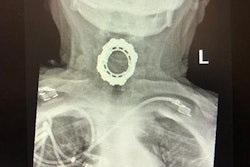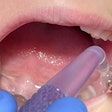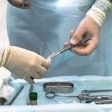
Patients experiencing isolated dysphagia may be showing early signs of a rare condition called Lambert-Eaton myasthenic syndrome (LEMS), according to a letter to the editor published on March 12 in the European Annals of Otorhinolaryngology, Head and Neck Diseases.
LEMS is an autoimmune disease affecting the nerves and muscles that often progresses slowly and begins with general weakness. Dysphagia, or swallowing difficulties, without other symptoms is a potential early sign of the condition, and this knowledge may lead to earlier diagnosis and better patient outcomes, according to authors.
"We report a rare and scarcely described presentation, an acute upper air-way obstruction, as the tip of the iceberg for the diagnosis of LEMS," wrote the group, led by Dr. Joana Costa from Porto University Hospital Center in Portugal.
Lambert-Eaton myasthenic syndrome causes a person's nerve cells and muscles to miscommunicate, resulting in gradual muscle weakness. Other common signs of the disease include difficulty walking, climbing stairs, and lifting objects, as well as dry mouth and drooping eyelids.
Dysphagia is a sign as well, but it typically occurs only in advanced stages of the disease. Between 24% and 34% of patients experience dysphagia with LEMS. Two other published reports have described patients with isolated dysphagia that was later associated with Lambert-Eaton myasthenic syndrome.
The current case emphasizes the idea that clinicians should have a high degree of suspicion regarding the origin of dysphagia, as the symptom could signify a more serious medical condition, the authors wrote.
A 70-year-old man
In their letter, Costa and colleagues described the case of a patient who smoked but had no major health problems. He was admitted to an emergency department due to acute respiratory distress after eating. He was observed by otorhinolaryngology after he was stabilized.
The patient underwent nasofibrolaryngoscopy, which revealed a foreign body occupying the glottic region. While the object was visualized, doctors used forceps to remove it via the oral cavity. The man showed immediate relief with no coughing or gagging during airway manipulation, the authors wrote.
Clinicians obtained a better medical history, learning that the man had experienced trouble swallowing solid food for a year and had lost 5 lb in three months without any other symptoms. He was evaluated by neurology to further investigate the cause of the dysphagia, which they suspected was Lambert-Eaton myasthenic syndrome.
This diagnosis was confirmed by the presence of antibodies against voltage-gated calcium channels and electrophysiological tests. Computed tomography with positron emission tomography revealed a nodule in the right upper lobe. Lung needle biopsy confirmed a small cell lung carcinoma, the authors wrote.
Having isolated dysphagia, including for a long duration, could be an initial manifestation of myasthenic syndromes, even when an associated tumor is discovered at their origin, according to the authors. Recognizing Lambert-Easton myasthenic syndrome and others neuromuscular disorders quickly is important, especially because treatment involves addressing the underlying cause, they noted.
This case "emphasizes the importance of considering isolated dysphagia as a clinical presentation of LEMS and other myasthenic syndromes, requiring a high level of suspicion to [make] possible an early diagnosis and to be able to orchestrate a systematic and multidisciplinary approach," Costa and colleagues concluded.



















